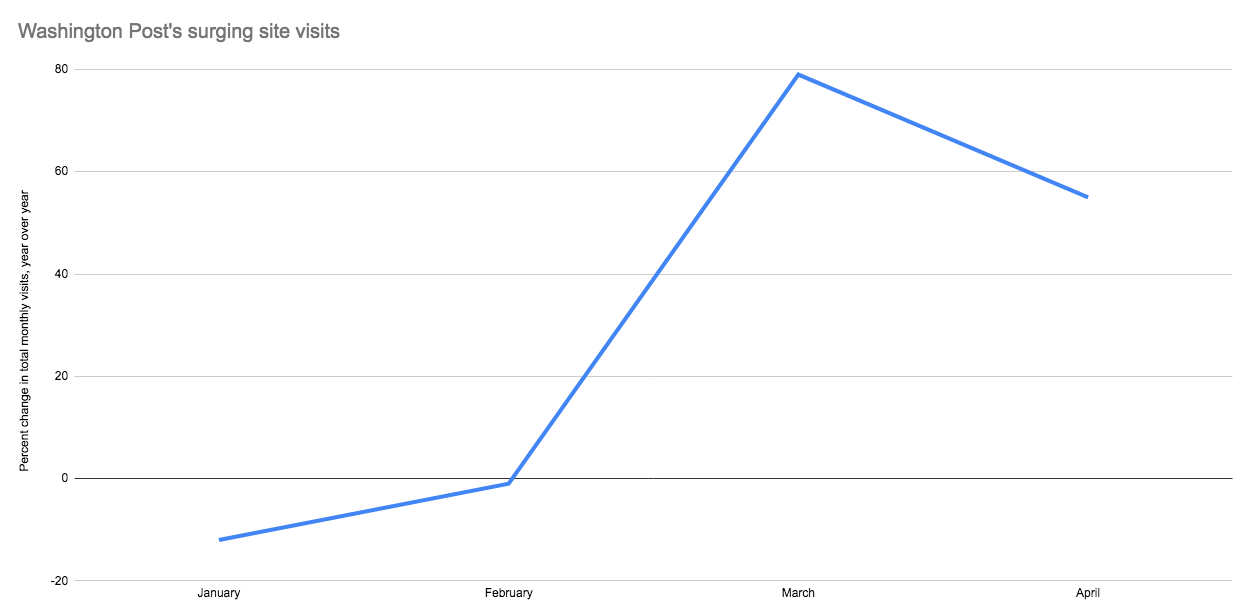In two months, The Washington Post’s coronavirus newsletter is its most popular

Like many publishers, The Washington Post put together a special email newsletter that carries the latest coronavirus coverage. In the span of just two months, the newsletter, which combines a reported top story with curated Post pieces about the pandemic, has become by far the most popular of the more than 60 email newsletters it offers — in fact, the Coronavirus Updates Newsletter is twice as popular as the No. 2 newsletter the Post offers.
The Post would not say how many subscribers the newsletter has but claims it gets a 40% open rate. The newsletter is not purely a monetization play, though the Post has managed to do direct-sold ad deals for it (Sponsors include Goldman Sachs, Slack, and Salesforce). Instead, it is an opportunity to establish a direction connection with new readers in the hope that they might become subscribers.
Over the past few years, news publishers have embraced email newsletters as a habit-forming tool that helps drive subscriptions. The New York Times, for example, recently made the decision to turn its morning briefing, which has 17 million subscribers, over to one of its highest-profile journalists, David Leonhardt.
“We’re always focused on habit-forming features, and we’re continuing to double down on that,” said Kat Downs Mulder, the Post’s vp of product.
The Post’s website had 139 million unique users in March and 111 million unique users in April, up 45% and 25% respectively from February, and many of those visitors came back frequently, leading to record traffic: Total site visits during those months were up 79% and 55% year over year, according to Comscore data.

Many of those users, Downs Mulder said, were new readers, drawn in by the Post’s coronavirus coverage, and on average, those new readers behaved differently than typical Post readers. They were more casual news consumers, and slightly younger, but the Post’s goal for them was identical to the one it has for regular readers: Building a habit.
To that end, the Post added more features to encourage recirculation, including a module at the top of article pages that connects users to the rest of its coronavirus coverage, and another one at the bottom featuring resources related to coronavirus, as well as a newsletter signup widget.
Though the coronavirus newsletter remains focused on its core subject, the Post has experimented with including more corona-adjacent content that showcases the breadth of the Post’s journalism.
The value of incremental coronavirus readers is likely to be lower than regular readers for most news publishers, said Rob Ristagno, the founder of Sterling Woods Group. But being able to build a habit in those readers, especially one that involves many different kinds of content, increases the chance that they’ll become subscribers.
Provided you introduce those new kinds of content at the right time. “If you try too soon, it can be off-putting,” Ristagno said, “but you can look at your data and figure out when to introduce it.”
More in Media

Podcast companies turn to live events to capture growing advertiser spend
The surge in the number of live podcast events in 2025 reflects a broader shift: advertisers are betting bigger on podcasts — not just as an audio channel but as a full-fledged creator economy play.

Media Briefing: ‘Cloudflare is locking the door’: Publishers celebrate victory against AI bot crawlers
After years of miserably watching their content get ransacked for free by millions of unidentified AI bot crawlers, publishers were finally thrown a viable lifeline.

How Vogue could navigate potential industry headwinds as Anna Wintour — who agency execs say made ad dollars flow — brings on new edit lead
Anna Wintour’s successor at Vogue will have to overcome the myriad of challenges facing fashion media and the digital publishing ecosystem.





